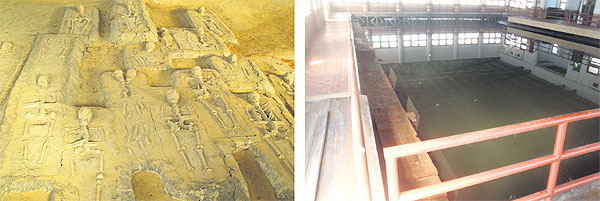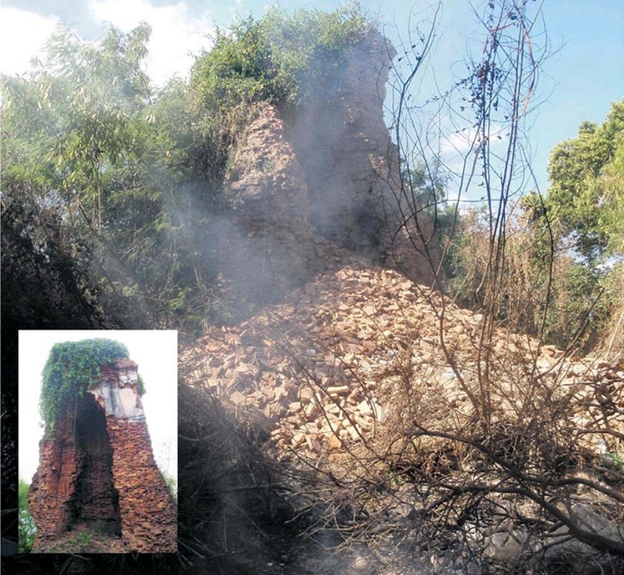The popular historic sites mentioned in guidebooks for their size and grandness will naturally receive more attention since tourists are willing to pay money to see them.
But what will happen to the remote historical sites; many of which are scattered off the main city island and covered by heavy vegetation? Does the nation need them more than a future apartment complex or factory?
 |
| Dozens of skeletons were found at the site of a Portuguese settlement in Ayutthaya in the 1970s. Right, the burial pit as it looks now after waters inundated the area. |
I wondered about this when I discovered that the main memorial tower of one of my favourite deserted temples, Wat Sam Jin, had collapsed into a thousand bricks.
This ruin was unknown to almost everyone, and now it is gone. It is comforting that I had led many students to this historic site while it stood. We photographed it earlier and created a document of what it once looked like.
Over time the bricks and artefacts in situ will be carried away by future floods. Wat Sam Jin will likely become a brick mound like dozens of others in the city.
I also wondered where the bones of Portuguese settlers had floated off to and if any of them had been saved.
showcase – to show the best qualities or parts of something แสดงจุดเด่นของสิ่งของหรือคน
collapse – to fall down suddenly พังลงมา ล้ม, พังครืน
nature takes its course – things that happen according to nature ปล่อยตามเรื่องธรรมชาติ
kayak – to travel using a kayak, a light canoe in which the part where you sit is covered over เดินทางด้วยเรือแคนูขนาดเล็ก
paved – covered with a hard flat surface of pieces of stone, concrete or bricks – ลาดทาง ancient – very old ที่เก่าแก่ ที่โบราณ
modernisation – the process of making a system, methods, etc. more modern and more suitable for use at the present time การทำให้ทันสมัย
exacerbate – to make something worse ทำให้แย่ลง inevitable – unavoidable; certain to happen ซึ่งหลีกเลี่ยงไม่ได้ locals – people who live in a particular place ชาวบ้าน
excessive – much greater than is usual; too much of something มากเกินปริมาณที่พอดี store – to keep for use in the future เก็บ drought – a long period of time when there is little or no water or rain ความแห้งแล้ง artery – an important road, railway, or river เส้นทางหลัก
dredge – to remove unwanted things from the bottom of a river, canal, lake, etc. using a sucking or other device ขุดลอก residents – people who live in a particular area ประชาชนที่อาศัยในท้องที่
stilts – a set of posts that a house is built on to raise it above the ground or above the level of water เสาค้ำ mound – a pile of something, such as earth or stones กองดิน กองหิน seek refuge
– to try to find a safe place where you can protect yourself from something dangerous or threatening หาที่หลบภัย,หาที่ปลอดภัย in contrast – different from ตรงข้ามกับ
survive – to continue to exist อยู่รอด สืบต่อไปได้ blocked – closed, so that nothing can get through ตัน
landlocked – of a place that has land all around it ที่ล้อมรอบไปด้วยแผ่นดิน
(water) hyacinth – a plant growing in water with large leaves ผักตบชวา rubbish – waste material or things that are no longer wanted or needed ขยะ
reservoir – a natural or artificial lake where water is stored อ่างเก็บน้ำ neighborliness – a particular area of a city or town ละแวก, ย่าน traces – very small amounts of a substance ร่องรอย
topple – to cause to fall คว่ำลงมา construct – to build or make some thing, especially buildings, bridges, etc. สร้าง severe – very serious and worrying ที่รุนแรง ที่น่าเป็นห่วง erode – to rub or be rubbed away gradually กร่อน, กัดกร่อน
monsoon – the seasonal changes Asian countries during which winds shift bringing more rain (southwest monsoon) and less rain(northeast monsoon) มรสุม tropical – relating to the hottest area of the Earth, between the Tropic of Cancer and the Tropic of Capricorn ในเขตร้อน
humidity – the amount of water that is present in the air ความชุ่มชื้น seep – (of a liquid) to flow slowly and in small quantities through something รั่วซึม
looter – someone who steals things from buildings, houses or shops, especially during a war or after a disaster ผู้ปล้นสะดม crack – a line on a surface where something is beginning to break apart รอยแตก รอยร้าว
architecture – in this case, the structure of a building
split – to divide; break apart ทำให้แตกแยก plaster – a substance made of lime, water and sand, that is put on walls and ceilings to give them a smooth hard surface ปูนฉาบผนัง
ruins – the remains of a building that has been badly damaged or destroyed ซากปรักหักพัง shift – to change; to move from one place to another เคลื่อนย้าย
balance – the ability to keep steady with an equal amount of weight on each side ความสมดุล, การทรงตัว
sink – to (cause something or someone to) go down below the surface or to the bottom of a liquid or soft substance จม
due to – because of เนื่องจาก maintenance – the act of keeping something in good condition by checking or repairing it regularly การซ่อมบำรุง site – a place where something is located สถานที่
time-consuming – taking a lot of time to do or finish nevertheless – despite what has just been said or referred to แต่อย่างไรก็ตาม
seek refuge – to try to find a safe place where you can protect yourself from something dangerous or threatening หาที่หลบภัย,หาที่ปลอดภัย
shelter – a place where people are protected from danger or bad weather; a temporary place to stay ที่หลบภัย ที่พักชั่วคราว
crumble – to break, or cause something to break, into small pieces แตกละเอียด function – to perform the action or the job of the thing or person mentioned ทำหน้าที่
huddle – to move close together in order to stay warm เกาะกลุ่มกันไว้ dilapidated – old and in bad condition ซึ่งชำรุดทรุดโทรม
foundation – supporting structure รากฐาน abandoned – left no longer used ที่ถูกละทิ้ง sermon – a talk on a moral or religious subject, usually given by a religious leader during a service การเทศนา
sermon hall – a large, open hall where lay people can hear sermons or receive religious education วิหาร, ศาลาการเปรียญ
host – to provide the space and other things necessary for an activity ทำหน้าที่เป็นเจ้าภาพ belongings – the things you own ข้าวของเครื่องใช้ deserted – empty ที่ถูกทิ้งให้ว่างเปล่า ร้างไป unquestionable – that cannot be doubted ที่ไม่ต้องสงสัย
popular – a situation in which someone or something is liked by many people เป็นที่นิยม, เป็นที่ชื่นชอบ attention – interest, especially interest that the public has in a person, event, situation etc ความสนใจ grandness – the impressive features of something, especially something large ความหรูหรา
remote – far away in distance ห่างไกล scattered – spread over a large area กระจัดกระจาย complex – a large building with various connected rooms or a related group of buildings
memorial – a statue, stone, etc. that is built in order to remind people of an important past event or of a famous person who has died อนุสรณ์
tower – a tall narrow building or part of a building, especially of a church or castle หอสูง,หอคอย,เจดีย์
favourite – something you like the best of all similar things ที่ชอบมาก,ที่โปรดปราน
brick – baked clay used for building walls, houses and other buildings อิฐ document – a paper or set of papers with written or printed information, especially of an official type เอกสาร
artifact – an object that was made a long time ago and is historically important, e.g., a tool or weapon โบราณวัตถุ in situ – in the original or correct place ในแหล่งกำเนิด
skeleton – the structure of bones that supports the body of a person or an animal โครงกระดูก
settlement a place where people come to live ชุมชน burial – the act of putting a dead body into the ground, or the ceremony connected with this การฝังศพ
inundate – to flood; to submerge ท่วม, ทำให้จมลงใต้น้ำ wonder – to think about something because you want to know more facts or details about it สงสัย settler
a person who arrives, especially from another country, in a new place and claims the land in order to live on it and farm it ผู้ตั้งถิ่นฐาน








